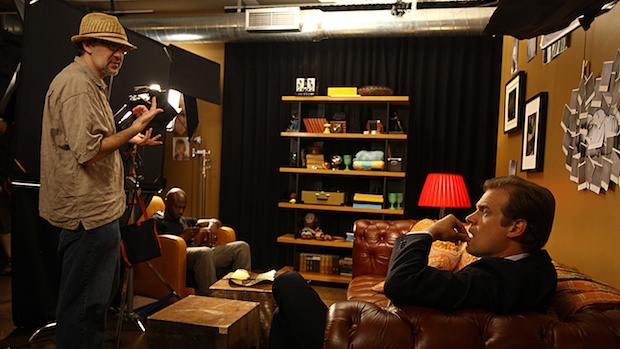Future of Film and TV. Poster.
The hierarchy of a media production.
Producer:







Vertical and Horizontal Integration:
Vertical integration is when a company owns a number of subsidiary companies within the same media sector. I.E 20th Century Fox owns a number of studios in Hollywood along with cinemas and television channels. This allows them to not only run their own productions with ease as they are in control of the outputs and development studios, but it also allows them to earn profit or save throughout all stages of a production, be it pre production, development or distribution.
Horizontal integration is when a media company owns a number of businesses of an equal value to its own. Media companies often take ownership over magazine, book or television companies as it assists the production company in reaching a wider audience.
So vertical integration is more involved with saving the production company money by owning other development companies, and horizontal integration is used to cover a wider ground and attract further audiences.
Legal and Ethical Considerations:
Watershed:
Broadcasting companies must abide by the watershed law, which is in place to protect young people from graphic images. The watershed dictates that footage unsuitable for a young audience should not be shown before 9 pm or after 5:30 am. That being said the transition to more adult broadcasts is not to be abrupt and should be a gradual increase in graphic content over the hours past the watershed.
Representations:
Broadcast media can be a powerful influence among the public, as such it is vital that the media industry ensures its use of representation is accurate, and avoids the use of negative stereotyping.
Bias:
When conducting a report, if the reporter has any prior impressions or beliefs on the subject, then the reporter should state that before the report is carried out, allowing the audience the opportunity to make their own judgements on the subject, and to understand that the report shown may be influenced by the reporter's own beliefs.
The producer’s job is to oversee the entire production, they will seek out funding for the project, hire directors and have a hand in marketing, writing and casting. The producer is the lead on every production and will have the final say on executive decisions. They delegate the responsibility of film making to the director.


Writer:
The writer’s job is not only to write the initial script, but it is also to aid with the production in terms of rewrites, direction during production and aiding with the casting of a project. The writer works closely with a director and may even have some input into who is hired as a director as certain directors will be better at adapting certain screenplays to film.
Director:
A Director is the person that will be the determining factor on whether or not a project turns out well. They work with cinematographers, writers and actors in order to try and get the best performance out of each of them. The director works closely with the writers in order to better gauge the locations for filming, set dressing, actors to hire and to alter anything to make a better cinematic experience.




Cinematographer:
Cinematographers work very closely with the directors and the actors on productions in order to get the best cinematic experience. The cinematographer is responsible for working with the director to compose shooting scripts and camera plans. As composing camera plans, the cinematographer will also have to work with the sound technicians to decide which microphones would be best for scenes and the least intrusive to the scenes.
Sound Technician:
Sound technicians are responsible for the recording of audio during production and for the balancing/editing of sound during the post production of a shoot.
Actors:
Actors may sometimes have ideas on how to better portray their characters or on what may help with the narrative of a production, in which case they will often bring it up with the director, writer or cinematographer as well as other actors.
Editors:
The editor is the final role that will determine a production’s quality. They work closely with the director and the producer to ensure that the film turns out as it should and that any necessary changes are made in the edit.

Vertical and Horizontal Integration:
Vertical integration is when a company owns a number of subsidiary companies within the same media sector. I.E 20th Century Fox owns a number of studios in Hollywood along with cinemas and television channels. This allows them to not only run their own productions with ease as they are in control of the outputs and development studios, but it also allows them to earn profit or save throughout all stages of a production, be it pre production, development or distribution.
Horizontal integration is when a media company owns a number of businesses of an equal value to its own. Media companies often take ownership over magazine, book or television companies as it assists the production company in reaching a wider audience.
So vertical integration is more involved with saving the production company money by owning other development companies, and horizontal integration is used to cover a wider ground and attract further audiences.
Legal and Ethical Considerations:
Watershed:
Broadcasting companies must abide by the watershed law, which is in place to protect young people from graphic images. The watershed dictates that footage unsuitable for a young audience should not be shown before 9 pm or after 5:30 am. That being said the transition to more adult broadcasts is not to be abrupt and should be a gradual increase in graphic content over the hours past the watershed.
Representations:
Broadcast media can be a powerful influence among the public, as such it is vital that the media industry ensures its use of representation is accurate, and avoids the use of negative stereotyping.
Bias:
When conducting a report, if the reporter has any prior impressions or beliefs on the subject, then the reporter should state that before the report is carried out, allowing the audience the opportunity to make their own judgements on the subject, and to understand that the report shown may be influenced by the reporter's own beliefs.





Comments
Post a Comment